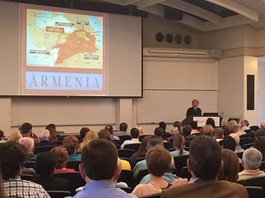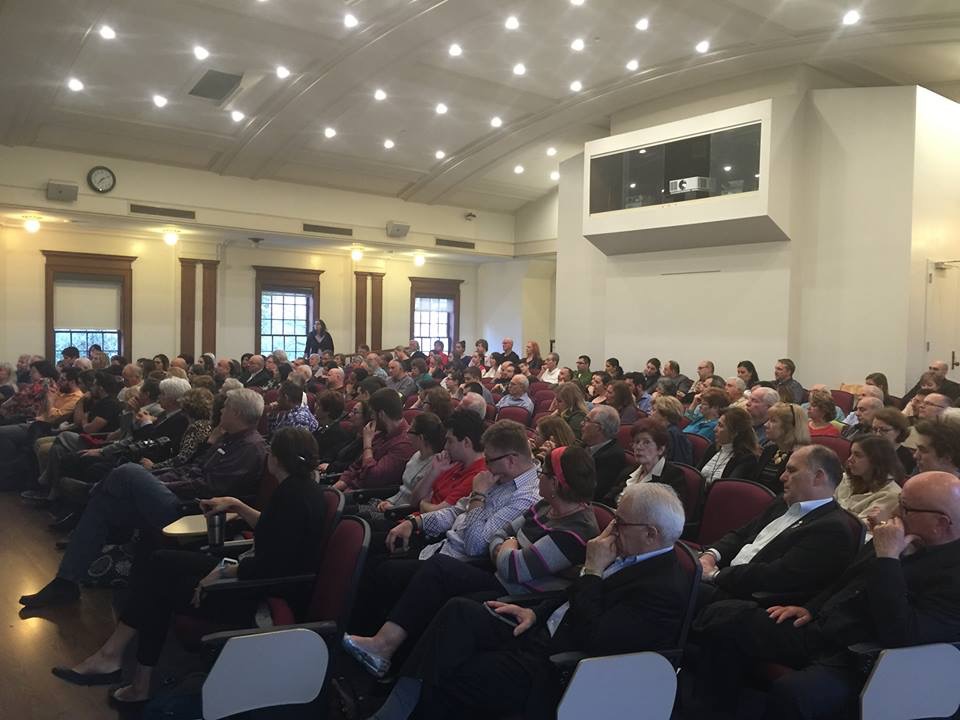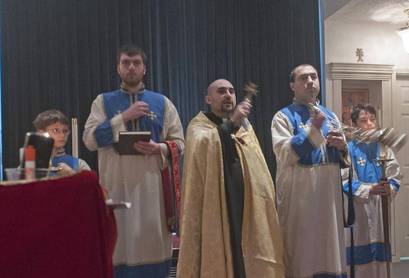 The Armenian Genocide Centennial Committee (AGCC) of DFW sponsored “An Evening with Peter Balakian” on Thursday March 19, 2015 in cooperation with the Embrey Human Rights Program at the Southern Methodist University (SMU). The topic of the presentation was “Raphael Lemkin, Cultural Destruction and the Armenian Genocide.” Peter Balakian is the preeminent author of several widely translated books on the Armenian Genocide, notably Black Dog of Fate, and The Burning Tigris among others. He is also the author of several works of poetry, including June Tree and Ziggurat. He has been teaching at the Colgate University since 1980, and over time has garnered many awards for his literary accomplishments as well as his work towards promoting an understanding of the evils of genocide, specifically the need for the recognition and condemnation of the Armenian Genocide around the world. Approximately 200 attendees filled the McCord Auditorium at SMU that evening. The mood was somber, but everyone was eager to listen to the accomplished speaker. Professor Rick Halperin, chairman of the Embrey Human Rights Program and a noted human rights and genocide scholar, welcomed everyone and introduced the topic of the Armenian Genocide as the example of a crime against humanity that was subsequently used to justify the Holocaust, and spoke about how the events that went unpunished during WWI caused greater tragedy in WWII. He reminded everyone that this was the 100th commemoration of the horrifying events that were perpetrated under cover of war, and called the 20th Century the “Century of Genocide” during which 70Million people perished violently. He stressed that everyone should struggle to remember these events so history does not fade away. Then Peter Balakian was introduced, and he began by thanking the AGCC Chairman Hamlet Sarokhanian for sponsoring his evening, and explained how Raphael Lemkin coined the word “Genocide” to mean the destruction of a people and their culture by systematic steps that involved separating the people from their ancestral lands, forcing them to deny their religion, language and history, killing all their leaders and vilifying all attempts at self-governance. Lemkin was instrumental in introducing Genocide as a crime against humanity in the charter of the United Nations. His definition of Genocide fit the experiences of the Armenians under the Ottoman Empire, where all cultural institutions, including churches and schools were destroyed, and all prominent leaders of the community were killed to leave the people unprotected and defenseless. Some of the examples cited for the existence of a systematic plan to exterminate the Armenians included the fact that out of 2538 churches in a list from 1913-1914, only 7 exist now, and of 1996 schools during the same period, there are only a handful.
Balakian’s message was clear: He looked forward to a day in which the Turkish government will recognize the atrocities that had taken place earlier, and not to keep promoting a revised version of the history. He cited current enlightened intellectuals among the Turkish community who had had to face persecution from their government to get the message out to all that the history taught in Turkish schools was incorrect. As Balakian put it:” How could you go to the ruins of the ancient capital of Armenia, Ani, and not see any mention of Armenians on any of the signs?” There were a couple of tense moments when Turkish individuals challenged Balakian saying that there was no proof that such atrocities had taken place, and if there was, why weren’t the Armenians taking it to a world court instead of spreading lies? Balakian replied that the Turkish government had taught its citizens the revised history, so he did not blame these men for not knowing the facts, and he encouraged them to read the words of those Turkish intellectuals who were serving time for telling the truth instead of listening to their government’s point of view. After the presentation there was a rush to buy Balakian’s books, which he gladly signed, with the net income benefiting the centennial events sponsored by the AGCC. By Mary Mukhtarian
2 Comments
On Sunday, March 22nd, Taline and Friends appeared at the St. Sarkis Armenian Church in Carrollton, Texas. The show was so popular that it was completely sold out, and everyone got a treat with Taline performing for an hour and a half in the church hall. The audience got to hear many of their favorite Taline songs, including “Im Kntag”, “Tzkneeg” and “Peesoee Bar”. Children of all ages danced with Taline and her friends, Tzagratzoo, Napik, and Peeso. Producer and CEO of TalineMusic Alex Bessos, also performed alongside the cast of everyone’s favorite Armenian characters. Taline and Friends have played a major role in developing Armenian language skills for children worldwide since the early 90s. Taline and Alex have performed in several countries including France, Canada, Lebanon and of course countless cities in North America. There is no doubt that without Taline’s music, being an Armenian kid wouldn’t be near as much fun! The community is truly blessed to have this unique performance happen right in its backyard. We would like to extend our thanks to the Akilian, Davoudian, Gostanian, Marzwanian and Sherenian families for enabling us to bring Taline and Friends to the Dallas Forth Worth metroplex. Their generous support allowed all to attend this once-in-a-lifetime event for a fraction of the ticket value. All proceeds from the show will benefit parish families in need. By Nina Smith 3/20/2015 St. Sarkis Armenian Orthodox Church remembers 100th anniversary of Armenian Genocide, plans to build new church.Read NowThough they share an ethnic background, they don’t always speak the same dialect.
Some mix Arabic with their Armenian words. Others blend in Farsi. But on Sundays, members of St. Sarkis Armenian Orthodox Church gather to worship in a sanctuary — once an abandoned home — in a Carrollton neighborhood. There, the pews creak and incense and candles fill the room in a smoky haze. The entrance to the church looks like that of any other home in the neighborhood, with a front door of wood and glass. Later, church members added a cultural hall with a large kitchen and classrooms. It’s where they gather to eat and mingle after the two-hour service. More than two decades since converting the home on Random Road, the building remains the only Armenian church in North Texas, members said. Now, it’s a gathering post for the ethnic group, many of whom immigrated to the United States from Turkey, Iran, Syria, Lebanon and Armenia, among others. “We have a belief that whenever there are two Armenians anywhere, together they build a little Armenia,” said Hamlet Sarokhanian, member of the church’s Parish Council and an immigrant from Iran. Remembering the past The massacre of Armenians a century earlier scattered survivors to five continents in search of refuge. Now, their descendants have found new homes in countries such as the U.S., Syria, France and Lebanon. In 1915, leaders of the Turkish government began a plan to expel and massacre Armenians living in the Ottoman Empire, many historians say. When it ended, about 1.5 million Armenians were dead, and others were forcibly removed. This year, St. Sarkis and other Armenian churches around the world will remember the 100th anniversary of the Armenian genocide. The church began planning the commemoration, which runs throughout the year, in 2013. On Thursday, author Peter Balakian spoke about the genocide at Southern Methodist University. “We believe it’s an incomplete mourning. It never got resolved. It got forgotten,” said Sarokhanian, who is also chairperson of the Armenian Genocide Centennial Committee of Dallas. “It’s been passed down from generations to generations. That is what keeps us unified.” He remembers the stories his father told him about his two uncles who died after walking for days through the desert from Iran to Iraq. His father wasn’t born yet. “We only know the history from our families,” he said. “It was chaos.” Julieta Chatinyan and her daughters, Lusine Meeks of Plano and Anahit Ballard of Frisco, understand the chaos. They wear handmade purple forget-me-not flower pins on their shirts. They’re a reminder of their late mother and grandmother, a survivor of the Armenian genocide who escaped from Palestine on one of the last trains. “This year’s campaign isn’t as much about Armenian genocide as it is about stop genocide,” said Meeks, who also serves on the church’s centennial committee. She and her sister were raised in the the former Soviet Union. Since schools were censored, the daughters learned about their grandmother’s story from Chatinyan. The flowers are among 200 that Chatinyan crocheted for church and community members to mark the genocide’s centennial. The purple flower is the official emblem of the 100th anniversary of the Armenian genocide. “We’re wearing it as a forget-me-not of all the victims of the genocide, but you can wear it to remember anyone who was close to you,” Ballard said. Moving forward Shant Aghyarian’s great-grandparents died in the march through the Syrian desert to Lebanon. Aghyarian, 25, a member of the genocide centennial committee, said the details are mostly unknown. Though Aghyarian was born in the U.S., his father immigrated here years earlier after fleeing to Cyprus when he was 13 years old to escape a civil war in Lebanon. His father owned a deli in Houston before opening a car body shop in Dallas. Aghyarian grew up in the church. At the time, the Armenian community was a small, growing population. Most, like his father, had moved for economic opportunities. Many were recent immigrants. When he was 9, his family returned to Lebanon. He moved back to Dallas in 2011 to pursue graduate studies in biomedical engineering at the University of Texas at Dallas. He left an infant church and returned to find it established and growing. “I was there when [the church] opened, but I was too young to realize what was going on,” Aghyarian said. “I came back to find it getting bigger and bigger.” The church opened its doors in the renovated home in 1991. Now, the church counts about 350 active families in the Dallas-Fort Worth area. People commute from around North Texas to attend Sunday services, and some even trek from Oklahoma. Now, the church plans to build a new facility about three times larger than its current space in West Plano near Prestonwood Baptist Church. It plans to expand programs and offer athletics. “The place we had was perfect for what could be accomplished at the time with limited funds and limited people. At this point, we’ve grown and it’s time to expand,” said Vahe Dayian, chairman of the church’s Parish Council. “What we’re trying to do now is reach more people who have not been part of the [church].” Land was donated to the church about three years ago by a member. Now, leaders are working to raise funds to construct the building. Dayian said they lack about 25 percent of the $1 million goal needed to begin construction. They hope to begin building as soon as possible. “It would be poetically perfect to build the church 100 years after we were suppose to be annihilated,” Dayian said. Reporter Nanette Light can be reached at 214-977-8039. MORE INFO April 18: Texas Peace March to state capitol in Austin April 23: Dedication to Armenian composers from noon to 1 p.m. on Classic Cafe show on WRR 101.1 Classical Radio. April 24: Candlelight and peace walk to Dallas City Hall from 5 to 8 p.m. April 30: Armenian genocide documentary will be shown 6:30 to 8:30 p.m. at the Dallas Holocaust Museum, 211 N. Record St., suite 100 in Dallas. For more information, email [email protected]. By NANETTE LIGHT Source: http://www.dallasnews.com To read a short summary of this article in Armenian, please click here. The Women's Guild and The Seniors of St. Sarkis Armenan Church celebrated Michink potluck luncheon and the W.G. quarterly meeting on Saturday March 14, at Kechejian Hall. Everyone enjoyed the delicious vegetarian Lenten dishes. We applaud W.G. For their hard work and their creativity to raise funds throughout the year. They are the back bone of all Armenian churches. All Armenian churches started with the establishment of W.G. In 2014, The W.G. raised $20,000 for St. Sarkis Church, bravo. God bless the work of your hands. Mrs. Seta Vosganian, one of our cherished Seniors talked about beloved Armenian Satirist writer, Hagop Baronian. Then we acknowledged and celebrated all the March birthdays. Shevan and Maral brought to our attention about the upcoming events for the Armenian Genocide Centennial. We salute the Armenian Genocide Centennial Committee for their passion and dedication to honor our victims. Thank you Salpi for showing the moving video of the life of Mary. Also thanks to Salpi everyone got a goodie bag with an inspirational book. "Kitch me amen pan."
A little of everything is the best way to describe this wonderful gathering. By Annie Graham |



